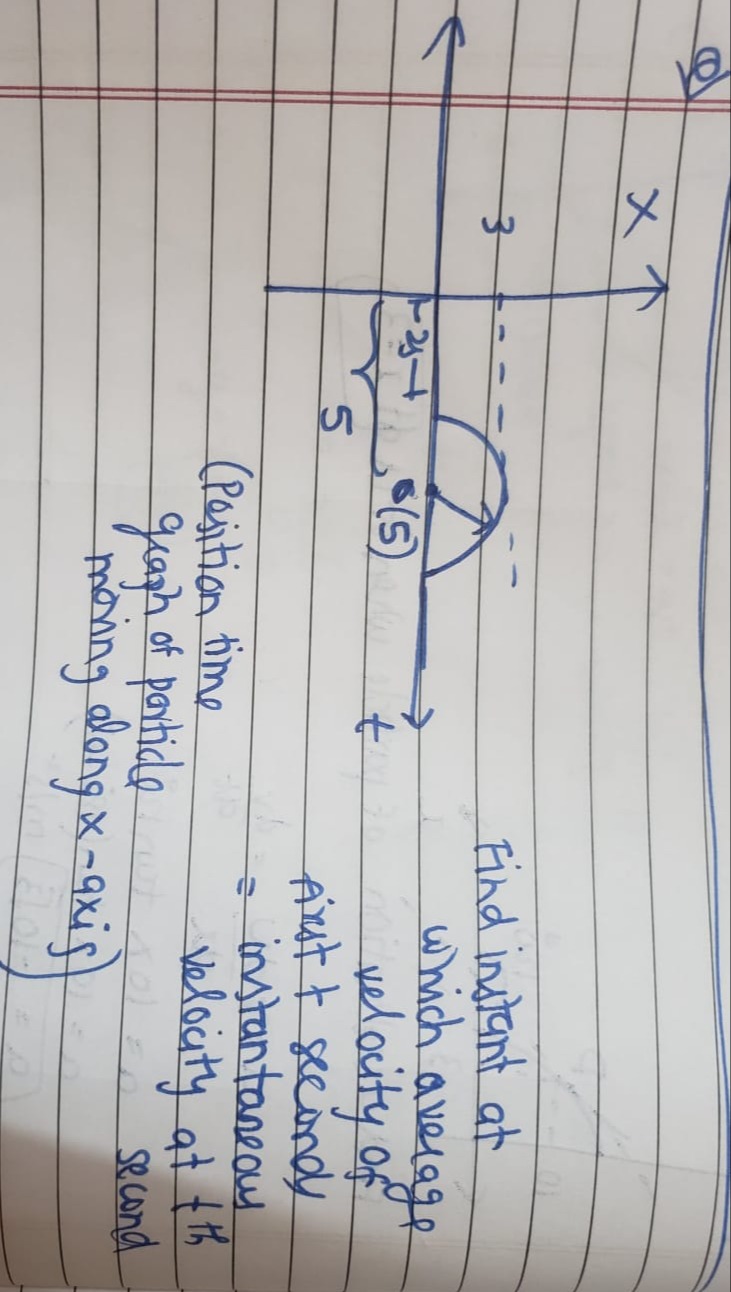Question
Question: Find instant at which average velocity of First & second = instantaneous velocity at t th second (Po...
Find instant at which average velocity of First & second = instantaneous velocity at t th second (Position time graph of portide moving along x-axis)

3.2 seconds
Solution
The problem asks for the instant t at which the average velocity from the beginning of the motion (assumed to be t=0) to time t is equal to the instantaneous velocity at time t. The position-time graph is a semicircle.
1. Analyze the Position-Time Graph: The graph shows a semicircle in the x-t plane.
- The x-axis represents time (t).
- The y-axis represents position (x).
- The semicircle starts at t=2 and ends at t=8.
- The center of the semicircle is at
t = (2+8)/2 = 5. Since the semicircle is centered on the t-axis (x=0), the center coordinates areC = (5, 0). - The radius of the semicircle is
R = (8-2)/2 = 3. - The semicircle is drawn below the t-axis, meaning the position
xis negative for points on the semicircle (except at t=2 and t=8 where x=0). - The equation of the semicircle is (t−5)2+x2=R2, which is (t−5)2+x2=32=9.
- Since x is negative, x(t)=−9−(t−5)2 for 2≤t≤8.
2. Define Average and Instantaneous Velocity:
- Average velocity from
t=0tot: Assuming the particle starts atx=0att=0, the average velocity is vavg=t−0x(t)−x(0)=tx(t). - Instantaneous velocity at
t: This is the derivative of position with respect to time, vinst=dtdx.
3. Set up the Condition:
We need to find t such that vavg=vinst, i.e., tx(t)=dtdx.
4. Calculate dtdx: Given x(t)=−9−(t−5)2=−[9−(t−5)2]1/2. Using the chain rule: dtdx=−21[9−(t−5)2]−1/2⋅dtd(9−(t−5)2) dtdx=−21[9−(t−5)2]−1/2⋅(−2(t−5)) dtdx=9−(t−5)2t−5 Since x(t)=−9−(t−5)2, we can write 9−(t−5)2=−x(t). So, dtdx=−x(t)t−5.
5. Solve the Equation tx(t)=dtdx: Substitute the expressions for x(t) and dtdx: tx(t)=−x(t)t−5 Cross-multiply: −x(t)2=t(t−5) From the equation of the semicircle, x(t)2=9−(t−5)2. Substitute this into the equation: −(9−(t−5)2)=t(t−5) −9+(t−5)2=t(t−5) Expand (t−5)2: −9+(t2−10t+25)=t2−5t t2−10t+16=t2−5t Subtract t2 from both sides: −10t+16=−5t Add 10t to both sides: 16=5t t=516 t=3.2 seconds.
6. Verify the Solution:
The obtained time t=3.2 seconds is within the domain of the semicircle, which is 2≤t≤8.
At t=3.2:
x(3.2)=−9−(3.2−5)2=−9−(−1.8)2=−9−3.24=−5.76=−2.4.
vavg=3.2x(3.2)=3.2−2.4=−3224=−43=−0.75 units/sec.
vinst=−(−2.4)3.2−5=2.4−1.8=−2418=−43=−0.75 units/sec.
The average velocity equals the instantaneous velocity at t=3.2 seconds.
Alternative Geometric Approach: The condition tx(t)=dtdx means that the line connecting the origin (0,0) to the point (t,x(t)) on the curve is tangent to the curve at that point. For a circle (or semicircle), the tangent line at a point is perpendicular to the radius drawn to that point. Let O be the origin (0,0), P be the point (t,x(t)) on the semicircle, and C be the center of the semicircle (5,0). Triangle OCP is a right-angled triangle with the right angle at P. The lengths of the sides are:
- OC=(5−0)2+(0−0)2=5 (distance from origin to center).
- CP=R=3 (radius of the semicircle).
- OP=(t−0)2+(x−0)2=t2+x2 (distance from origin to point P). By the Pythagorean theorem in △OCP: OP2+CP2=OC2 (t2+x2)2+32=52 t2+x2+9=25 t2+x2=16 (Equation 1) The point P(t,x) is on the semicircle, so it satisfies the semicircle equation: (t−5)2+x2=9 (Equation 2) From Equation 2, x2=9−(t−5)2. Substitute this x2 into Equation 1: t2+(9−(t−5)2)=16 t2+9−(t2−10t+25)=16 t2+9−t2+10t−25=16 10t−16=16 10t=32 t=3.2 seconds.
